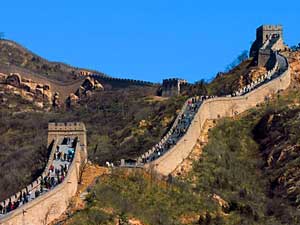China ETF Opportunities - Which One to Select?
Selecting appropriate China ETF can be crucial when you are looking for a way to get exposed to this highly growth country with endless opportunities.
In this beginners guide to investing in China we will overview different possibilities of getting exposed to Chinese stock market via Exchange Traded Funds traded on the US Stock Exchanges. But first of all, why would anyone invest in Chinese stocks? It is not a secret that the growth gap of emerging and developed countries is widening - while the western countries are looking for ways to get out of troubles caused by the last financial crisis, some emerging markets with China ahead are still growing at significant rate of over 8% per annum. Many economists expect China to become the world's largest economy in the years ahead. High growth is not the only factor welcoming global investors to invest in emerging markets such as China. If just a few years ago emerging markets were the one associated with high risk, nowadays investors see more risks connected with developed world, like aging population, health care reforms, over-indebtedness, etc. These two are the major reasons why U.S. and international investors have chosen to diversify their portfolios of domestic equities in favor of a more global approach, most of them significantly increasing the allocation to Chinese stocks.
China Price Movers
Before we move to overview of ETF's which are exposed to Chinese market (China ETF), let's look at the factors influencing China economy. One of the most important factors driving the Chinese economy is definitely the currency regime. While China is under global pressure to allow the Yuan to fluctuate freely, since Yuan is strongly undervalued, this is not something we could see in practice. Low value of Yuan is strong catalyst of Chinese export, which is still the main generator of high GDP growth in China, so we can understand their point of view. Until the domestic consumption will become strong enough, we could see more or less the same currency policy. Another important factor influencing China economy is infrastructure development and modernization of rural China. As investor in China you also have to be aware of the fact, that China is a communist nation and that government still has heavy control over some sectors (like Financials), although it has opened to foreign investors in recent years. In terms of politics, China is playing an important role in geopolitical tensions in Asia. And finally, when you think of China always think of them in relation to commodities. China is the largest user of energy in the world, they are one of the largest importers of industry metals and as the largest nation in the world also their consumption of agricultural commodities is exponentially growing. Prices of commodities can therefore have a strong impact on their industries.
China ETF Universe

Now let's move to China ETFs overview. Selecting China ETF can be the easiest and most affordable way to get exposed to Chinese stocks. However, there are number of different ETF's tracking China, some of them focusing on large-caps, other on small-caps, some are focused on special sectors and industries, others offer you inverse or leveraged exposure, you can even get exposed to Chinese real-estates or Chinese currency if you want. While ETF's exposed to China are traded on several stock markets (U.S., London, Frankfurt, Hong Kong, etc.), we will focus only on those trading on American stock markets.
Large-Cap China ETFs
There are three major large-cap ETFs targeting China: FXI, GXC and PGJ.
| Ticker | China ETF (link to fund provider) |
Expense Ratio | Dividend |
|---|---|---|---|
| FXI | iShares FTSE/Xinhua China 25 Index Fund | 0.74% | 6 mon. |
| GXC | SPDR S&P China Fund | 0.59% | 6 mon. |
| PGJ | PowerShares Golden Dragon Halter USX China Portfolio | 0.60% | Quart. |
iShares FTSE/Xinhua China 25 Index Fund (FXI) is the largest of them, with the highest average daily trading volume, but it is not the most diversified. This ETF has about 25 holdings, where top 10 are representing over 60% of this China ETF portfolio. Almost 50% of portfolio is exposed to financial sector, 25% to energy, and then 15% to telecommunications, 7% industrial materials, 3% business services and so on. As you can see, there is no significant exposure to consumer sector, which is a drawback for investors looking to gain out of growing middle class in China. If you are considering to buy this ETF, you might be interested in some ideas about Where is iShares FTSE/Xinhua China 25 Index Fund (FXI) price heading?
The second largest and most traded China ETF is SPDR S&P China ETF (GXC). This ETF is far more diversified across all sectors and industries than FXI, while tracking the universe of publicly traded companies domiciled in China that are legally available to foreign investors. GXC has around 150 holdings, where top 10 represent around 45% of the portfolio. A third of portfolio is exposed to financials, 18% to telecoms, 16% to energy, 14% to industrial materials, 5% to business services, 4% to consumer goods, 3% to consumer services, 1.5% to utilities, 1% to health care and so on.
And the third largest China ETF is PowerShares Golden Dragon Halter USX China Portfolio (PGJ). This ETF tracks U.S. listed companies that derive a majority of their revenues from the People's Republic of China. A unique investing approach with almost 200 holdings, where top 10 positions represent around 50% of the portfolio. According to sector breakdown, telecoms represent 25%, energy 22%, business services 10%, industrial materials 9%, financial 6%, hardware 5%, consumer services 5%, software 5%, health care 4%, utilities 3%, media 2% and consumer goods 2%.
All-Cap and Small-Cap China ETFs
| Ticker | China ETF (link to fund provider) |
Expense Ratio | Dividend |
|---|---|---|---|
| YAO | Claymore/AlphaShares China All-Cap ETF | 0.70% | Annually |
| HAO | Claymore/AlphaShares China Small Cap Index ETF | 0.70% | Annually |
Claymore/AlphaShares China All-Cap ETF (YAO) is an all-cap China ETF, for investors looking to cover the whole spectrum of Chinese stocks. With almost 200 holdings, financials represent about a third of fund's portfolio, energy and telecoms about 17%, industrial materials 12%, consumer goods 5%, business services 4%, consumer services 3%, utilities 1.5%, health care 1.5% and so on. Top 10 holdings represent around 40% of portfolio.
Claymore/AlphaShares China Small Cap Index ETF (HAO) is a small-cap China ETF, which is looking to exposure to Chinese companies with a float-adjusted market capitalization between $200 million and $1.5 billion, while a single holding cannot weight over 2.2% of the portfolio. All these characteristics make this ETF strongly diversified. Top 10 out of around 200 holdings represent only about 12% of the portfolio. Industrial materials are the largest sector with about 28%, consumer goods 16%, financials 10%, consumer services 9%, business services 9%, health care 6%, telecommunications 4%, software 3%, hardware 3%, utilities 3%, energy 2% and so on.
China Sector ETFs
There are several ETFs offering you to gain exposure to China specific sectors. Two of them are exposed to technology sector: Global X China Technology ETF (CHIB) and Claymore China Technology ETF (CQQQ), while there is one ETF available in the time of writing to gain exposure to other sectors: Global X China Energy ETF (CHIE), China Materials ETF (CHIM), China Consumer ETF (CHIQ), INDXX China Infrastructure Index Fund (CHXX), Global X China Financials ETF (CHIX). You can find the most important information about sector ETF's in the table below and additional information on the official websites of fund providers.
| Ticker (chart) |
China ETF (link to fund provider) |
Expense Ratio | Dividend |
|---|---|---|---|
| CHIB |
Global X China Technology ETF | 0.65% | Annually |
| CQQQ |
Claymore China Technology ETF | 0.70% | Annually |
| CHIE |
Global X China Energy ETF | 0.65% | Annually |
| CHIM |
China Materials ETF | 0.65% | Annually |
| CHIQ |
China Consumer ETF | 0.65% | Annually |
| CHXX |
INDXX China Infrastructure Index Fund | 0.85% | Annually |
| CHIX |
X China Financials ETF | 0.65% | Annually |
China Inverse/Leveraged ETFs
If you don't believe in further growth of Chinese stocks, which could be only short-term, there are some of inverse ETFs available for you. Some of them come with leverage as well. Leverage ETFs are something to amplify exposure to Chinese stock markets, which is suitable for more dynamic investors.
| Ticker | China ETF (link to fund provider) |
Expense Ratio | Dividend |
|---|---|---|---|
| YXI | ProShares Short FTSE/Xinhua China | 0.95% | Quart. |
| XPP | ProShares Ultra (2x) FTSE/Xinhua China 25 | 0.95% | Quart. |
| FXP | ProShares Ultrashort (2x) FTSE/Xinhua China | 0.95% | Quart. |
| CZM | Direxion Daily China Bull 3x Shares | 0.94% | Quart. |
| CZI | Direxion Daily China Bear 3x Shares | 0.96% | Quart. |
Short FTSE/Xinhua China (YXI) is a ProShares China ETF that seeks to deliver daily returns equal to the inverse of the FTSE/Xinhua China 25 Index.
Then there are two ETFs offering you 2-times of daily exposure, one long and one short. ProShares Ultra FTSE/Xinhua China 25 (XPP) is 2x leveraged ETF linked to the FTSE/Xinhua China 25 Index, seeking to deliver 200% of that benchmark's daily returns, while ProShares Ultrashort FTSE/Xinhua China (FXP) is XPP's bear counterpart.
If you are looking for even higher leverage, the 3-times of daily exposure might be what you are looking for. Direxion Daily China Bear 3x Shares (CZI) China ETF seeks daily returns equal to -300% of the change in the Bank of New York Mellon China Select ADR Index, a benchmark made up of companies that have a primary equity listing on a stock exchange in China. And Direxion Daily China Bull 3x Shares (CZM) is the opposite of the CZI.
China Real Estate ETFs
Real-estate is a segment of China economy which could be currently overvalued according to come economist's warnings. Chinese real estate market is known for high volatility, so investors should be careful when considering this type of investments in China. However, if you decide to go for it, Claymore/Alphashares China Real Estate ETF (TAO) might do the work for you.
| Ticker | China ETF (link to fund provider) |
Expense Ratio | Dividend |
|---|---|---|---|
| TAO | Claymore/Alphashares China Real Estate ETF | 0.65% | Annually |
This ETF is focusing on the performance of publicly-traded companies and REITs deriving a majority of their revenues from real estate development, management and/or ownership of property in China, Hong Kong, and Macau.
China Currency ETFs and ETNs
As mentioned in the beginning of this article, many economists believe that Chinese currency Yuan is undervalued against U.S. dollar and other currencies as well.
| Ticker | China ETF (link to fund provider) |
Expense Ratio | Dividend |
|---|---|---|---|
| CNY | Market Vectors-Chinese Renminbi/USD ETN | 0.55% | N/A |
| CYB | WisdomTree Dreyfus Chinese Yuan Fund | 0.45% | Annually |
There is an Exchange Traded Note available for investors to get exposure to China's currency: Market Vectors-Chinese Renminbi/USD ETN (CNY). While exchange traded notes (ETNs) are similar to exchange traded funds (ETFs), there is a slight difference regarding the structure of the product. ETNs are structured product issued by banks, while ETFs are stakes in the fund. ETNs therefore carry an additional credit risk of the issuer, which is something an investor should be careful about especially in financial crisis like the last one we have seen.
And there is a China ETF: WisdomTree Dreyfus Chinese Yuan Fund (CYB), which seeks to achieve total returns reflective of both money market rates in China available to foreign investors and changes in value of the Chinese Yuan relative to the U.S. dollar.
Written by: Goran Dolenc
Do you find this content useful? Like! Tweet! Recommend! Share!
Related Articles

Comparison of India ETF and ETN Opportunities
Selecting large-cap India ETF is only one of many possible ways to get exposed to Indian stock market. You can also invest in small-cap, inverse, leverage or ETN.

ETF Investing - Different Types of ETFs
ETF investing offers you are a perfect investing mix, because you can choose among different types of ETFs, like index, country, sector, currency, commodity, short, leverage...
Disclaimer! The information contained in this article is not warranted to be accurate, complete or timely and Stocks-For-Beginners.com is not responsible for any damages or losses arising from any use of this information. Past performance is no guarantee of future results. Stocks-For-Beginners.com is not an investment advisor, and any content published by Stocks-For-Beginners.com does not constitute individual investment advice. The opinions offered herein are not personalized recommendations to buy, sell or hold securities. From time to time, issuers of exchange-traded products mentioned herein may place paid advertisements with Stocks-For-Beginners.com. All content on Stocks-For-Beginners.com is produced independently of any advertising relationships.
Back from China ETF to Exchange Traded Fund
Back from China ETF to Best Online Trading Site for Beginners home page







